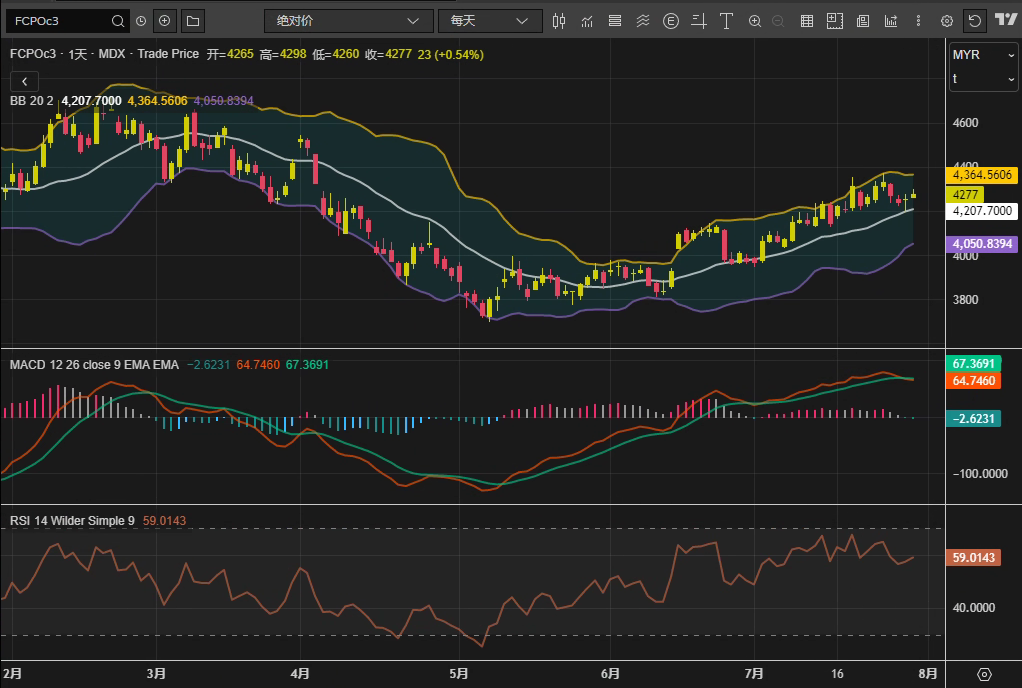Palm oil bulls and bears clash at 4,300 ringgit! Exchange rate advantage vs. soybean oil substitution: Positions signal a potential market reversal.
2025-07-30 19:07:23

Exchange rate dividend and external market linkage
The current market trend is primarily driven by two factors: first, the ringgit depreciated 0.09% against the US dollar, boosting the competitiveness of Malaysian palm oil exports priced in US dollars; second, soybean oil (DBYcv1) and palm oil (DCPcv1) contracts on the Dalian Commodity Exchange rose 0.81% and 0.63%, respectively. This, combined with an overnight surge in Chicago soybean oil futures, provided support for palm oil's price. Anilkumar Bagani, Head of Research at Sunvin Group, noted, "Strong energy futures performance and resilient demand in China's vegetable oil market are fueling bullish sentiment for palm oil."
However, the market is not entirely without concerns. Although Chicago soybean oil (BOcv1) fell 0.62% overnight, low-priced Chinese soybean oil exports to India are reshaping regional trade flows. Data shows that Indian importers recently made a rare purchase of 150,000 tons of soybean oil from China, setting a monthly record. Bagani warned: "Discounts offered by Chinese crushers due to domestic oversupply may squeeze palm oil's market share in India." If this substitution effect persists, it will offset some of the demand benefits from the exchange rate.
Biodiesel demand is under marginal pressure
Uncertainty in the energy market is also weighing on palm oil prices. International crude oil prices dipped slightly today, with the market focused on the potential impact of geopolitical developments on the supply side. Since the economics of palm oil as a biodiesel feedstock are highly correlated with crude oil prices, weak oil prices could dampen demand for B30/B35 biodiesel blends in Indonesia and Malaysia. However, crude oil prices remain within the support range of the summer peak demand season, with limited short-term downside potential. Palm oil's biodiesel performance has yet to fundamentally reverse.
Institutional view: A cautious balance under the interweaving of bullish and bearish factors
Analysts are divided on the outlook. Some traders believe that the weakening ringgit and the northern hemisphere's peak summer edible oil consumption season will likely continue to support prices, and that a break above the upper Bollinger Band of 4,364 ringgit would open up upside potential. However, cautious analysts emphasize that India's shift in soybean oil imports to Chinese soybean oil and fluctuations in the Chicago-Dalian oil price gap could dampen palm oil's upward momentum. An Asian oils and fats researcher at a prominent institution noted, "If the Dalian soybean oil premium continues to narrow, refineries will be more inclined to purchase South American soybean oil, which will put palm oil export data under scrutiny."
Pay attention to key price levels and policy signals
In the short term, the MYR 4250-4300 range will become a key battleground for bulls and bears. The market should closely monitor two signals: first, the Malaysian Palm Oil Association's (MPOA) production forecast in early August to determine whether the lagged effects of El Niño will lead to an unexpected tightening of supply; and second, Indonesia's potential adjustment to its export tariff policy. Any move to boost export competitiveness could intensify regional price competition. For professional traders, a swing trading strategy is more appropriate at this time, rather than betting on a single trend.

The current market trend is primarily driven by two factors: first, the ringgit depreciated 0.09% against the US dollar, boosting the competitiveness of Malaysian palm oil exports priced in US dollars; second, soybean oil (DBYcv1) and palm oil (DCPcv1) contracts on the Dalian Commodity Exchange rose 0.81% and 0.63%, respectively. This, combined with an overnight surge in Chicago soybean oil futures, provided support for palm oil's price. Anilkumar Bagani, Head of Research at Sunvin Group, noted, "Strong energy futures performance and resilient demand in China's vegetable oil market are fueling bullish sentiment for palm oil."
However, the market is not entirely without concerns. Although Chicago soybean oil (BOcv1) fell 0.62% overnight, low-priced Chinese soybean oil exports to India are reshaping regional trade flows. Data shows that Indian importers recently made a rare purchase of 150,000 tons of soybean oil from China, setting a monthly record. Bagani warned: "Discounts offered by Chinese crushers due to domestic oversupply may squeeze palm oil's market share in India." If this substitution effect persists, it will offset some of the demand benefits from the exchange rate.
Biodiesel demand is under marginal pressure
Uncertainty in the energy market is also weighing on palm oil prices. International crude oil prices dipped slightly today, with the market focused on the potential impact of geopolitical developments on the supply side. Since the economics of palm oil as a biodiesel feedstock are highly correlated with crude oil prices, weak oil prices could dampen demand for B30/B35 biodiesel blends in Indonesia and Malaysia. However, crude oil prices remain within the support range of the summer peak demand season, with limited short-term downside potential. Palm oil's biodiesel performance has yet to fundamentally reverse.
Institutional view: A cautious balance under the interweaving of bullish and bearish factors
Analysts are divided on the outlook. Some traders believe that the weakening ringgit and the northern hemisphere's peak summer edible oil consumption season will likely continue to support prices, and that a break above the upper Bollinger Band of 4,364 ringgit would open up upside potential. However, cautious analysts emphasize that India's shift in soybean oil imports to Chinese soybean oil and fluctuations in the Chicago-Dalian oil price gap could dampen palm oil's upward momentum. An Asian oils and fats researcher at a prominent institution noted, "If the Dalian soybean oil premium continues to narrow, refineries will be more inclined to purchase South American soybean oil, which will put palm oil export data under scrutiny."
Pay attention to key price levels and policy signals
In the short term, the MYR 4250-4300 range will become a key battleground for bulls and bears. The market should closely monitor two signals: first, the Malaysian Palm Oil Association's (MPOA) production forecast in early August to determine whether the lagged effects of El Niño will lead to an unexpected tightening of supply; and second, Indonesia's potential adjustment to its export tariff policy. Any move to boost export competitiveness could intensify regional price competition. For professional traders, a swing trading strategy is more appropriate at this time, rather than betting on a single trend.

Uncertainty in the energy market is also weighing on palm oil prices. International crude oil prices dipped slightly today, with the market focused on the potential impact of geopolitical developments on the supply side. Since the economics of palm oil as a biodiesel feedstock are highly correlated with crude oil prices, weak oil prices could dampen demand for B30/B35 biodiesel blends in Indonesia and Malaysia. However, crude oil prices remain within the support range of the summer peak demand season, with limited short-term downside potential. Palm oil's biodiesel performance has yet to fundamentally reverse.
Institutional view: A cautious balance under the interweaving of bullish and bearish factors
Analysts are divided on the outlook. Some traders believe that the weakening ringgit and the northern hemisphere's peak summer edible oil consumption season will likely continue to support prices, and that a break above the upper Bollinger Band of 4,364 ringgit would open up upside potential. However, cautious analysts emphasize that India's shift in soybean oil imports to Chinese soybean oil and fluctuations in the Chicago-Dalian oil price gap could dampen palm oil's upward momentum. An Asian oils and fats researcher at a prominent institution noted, "If the Dalian soybean oil premium continues to narrow, refineries will be more inclined to purchase South American soybean oil, which will put palm oil export data under scrutiny."
Pay attention to key price levels and policy signals
In the short term, the MYR 4250-4300 range will become a key battleground for bulls and bears. The market should closely monitor two signals: first, the Malaysian Palm Oil Association's (MPOA) production forecast in early August to determine whether the lagged effects of El Niño will lead to an unexpected tightening of supply; and second, Indonesia's potential adjustment to its export tariff policy. Any move to boost export competitiveness could intensify regional price competition. For professional traders, a swing trading strategy is more appropriate at this time, rather than betting on a single trend.

Analysts are divided on the outlook. Some traders believe that the weakening ringgit and the northern hemisphere's peak summer edible oil consumption season will likely continue to support prices, and that a break above the upper Bollinger Band of 4,364 ringgit would open up upside potential. However, cautious analysts emphasize that India's shift in soybean oil imports to Chinese soybean oil and fluctuations in the Chicago-Dalian oil price gap could dampen palm oil's upward momentum. An Asian oils and fats researcher at a prominent institution noted, "If the Dalian soybean oil premium continues to narrow, refineries will be more inclined to purchase South American soybean oil, which will put palm oil export data under scrutiny."
Pay attention to key price levels and policy signals
In the short term, the MYR 4250-4300 range will become a key battleground for bulls and bears. The market should closely monitor two signals: first, the Malaysian Palm Oil Association's (MPOA) production forecast in early August to determine whether the lagged effects of El Niño will lead to an unexpected tightening of supply; and second, Indonesia's potential adjustment to its export tariff policy. Any move to boost export competitiveness could intensify regional price competition. For professional traders, a swing trading strategy is more appropriate at this time, rather than betting on a single trend.

In the short term, the MYR 4250-4300 range will become a key battleground for bulls and bears. The market should closely monitor two signals: first, the Malaysian Palm Oil Association's (MPOA) production forecast in early August to determine whether the lagged effects of El Niño will lead to an unexpected tightening of supply; and second, Indonesia's potential adjustment to its export tariff policy. Any move to boost export competitiveness could intensify regional price competition. For professional traders, a swing trading strategy is more appropriate at this time, rather than betting on a single trend.

- Risk Warning and Disclaimer
- The market involves risk, and trading may not be suitable for all investors. This article is for reference only and does not constitute personal investment advice, nor does it take into account certain users’ specific investment objectives, financial situation, or other needs. Any investment decisions made based on this information are at your own risk.





















